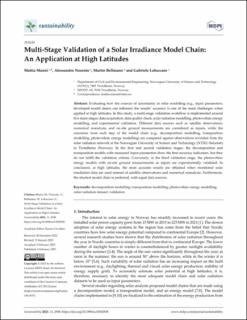Multi‐Stage Validation of a Solar Irradiance Model Chain: An Application at High Latitudes
| dc.contributor.author | Manni, Mattia | |
| dc.contributor.author | Nocente, Alessandro | |
| dc.contributor.author | Bellmann, Martin Pawel | |
| dc.contributor.author | Lobaccaro, Gabriele | |
| dc.date.accessioned | 2023-02-13T09:11:29Z | |
| dc.date.available | 2023-02-13T09:11:29Z | |
| dc.date.created | 2023-02-10T10:40:00Z | |
| dc.date.issued | 2023 | |
| dc.identifier.issn | 2071-1050 | |
| dc.identifier.uri | https://hdl.handle.net/11250/3050262 | |
| dc.description.abstract | Evaluating how the sources of uncertainty in solar modelling (e.g., input parameters, developed model chain) can influence the results’ accuracy is one of the main challenges when applied at high latitudes. In this study, a multi-stage validation workflow is implemented around five main stages: data acquisition, data quality check, solar radiation modelling, photovoltaic energy modelling, and experimental validation. Different data sources such as satellite observations, numerical reanalysis, and on-site ground measurements are considered as inputs, while the outcomes from each step of the model chain (e.g., decomposition modelling, transposition modelling, photovoltaic energy modelling) are compared against observations recorded from the solar radiation network at the Norwegian University of Science and Technology (NTNU-Solarnet) in Trondheim (Norway). In the first and second validation stages, the decomposition and transposition models with measured input parameters show the best accuracy indicators, but they do not fulfill the validation criteria. Conversely, in the third validation stage, the photovoltaic energy models with on-site ground measurements as inputs are experimentally validated. In conclusion, at high latitudes, the most accurate results are obtained when monitored solar irradiation data are used instead of satellite observations and numerical reanalysis. Furthermore, the shortest model chain is preferred, with equal data sources. | en_US |
| dc.language.iso | eng | en_US |
| dc.publisher | MDPI | en_US |
| dc.rights | Navngivelse 4.0 Internasjonal | * |
| dc.rights.uri | http://creativecommons.org/licenses/by/4.0/deed.no | * |
| dc.subject | validation | en_US |
| dc.subject | solar radiation dataset | en_US |
| dc.subject | photovoltaic energy modelling | en_US |
| dc.subject | transposition modelling | en_US |
| dc.subject | decomposition modelling | en_US |
| dc.title | Multi‐Stage Validation of a Solar Irradiance Model Chain: An Application at High Latitudes | en_US |
| dc.title.alternative | Multi‐Stage Validation of a Solar Irradiance Model Chain: An Application at High Latitudes | en_US |
| dc.type | Peer reviewed | en_US |
| dc.type | Journal article | en_US |
| dc.description.version | publishedVersion | en_US |
| dc.rights.holder | Copyright: © 2023 by the authors. Licensee MDPI, Basel, Switzerland. This article is an open access article distributed under the terms and conditions of the Creative Commons Attribution (CC BY) license (https://creativecommons.org/license s/by/4.0/). | en_US |
| dc.source.pagenumber | 18 | en_US |
| dc.source.volume | 15 | en_US |
| dc.source.journal | Sustainability | en_US |
| dc.source.issue | 4 | en_US |
| dc.identifier.doi | 10.3390/su15042938 | |
| dc.identifier.cristin | 2124788 | |
| dc.relation.project | Norges forskningsråd: 324243 | en_US |
| dc.source.articlenumber | 2938 | en_US |
| cristin.ispublished | true | |
| cristin.fulltext | original | |
| cristin.qualitycode | 1 |
Tilhørende fil(er)
Denne innførselen finnes i følgende samling(er)
-
Publikasjoner fra CRIStin - SINTEF AS [5802]
-
SINTEF Community [2248]
-
SINTEF Industri [1566]

